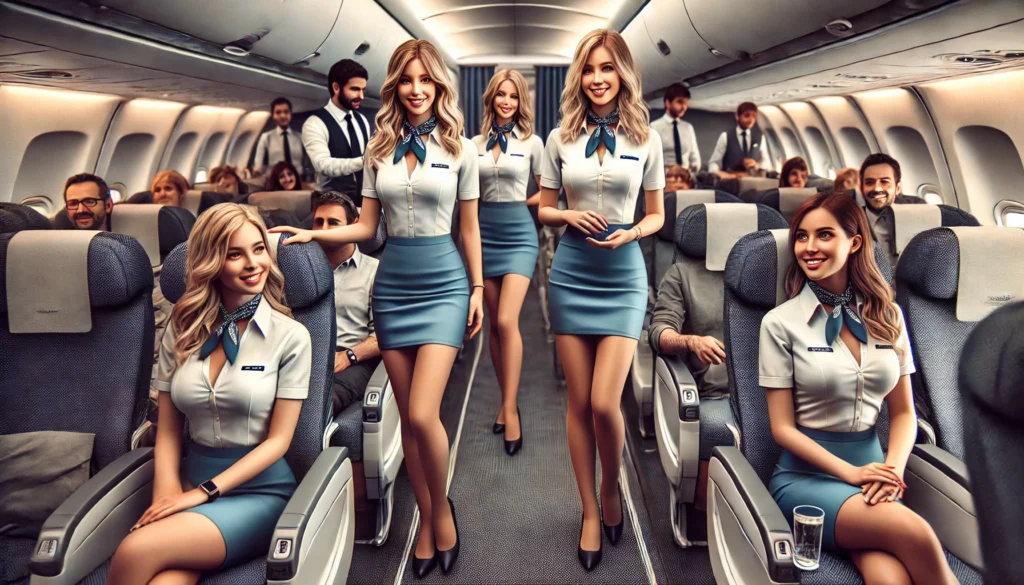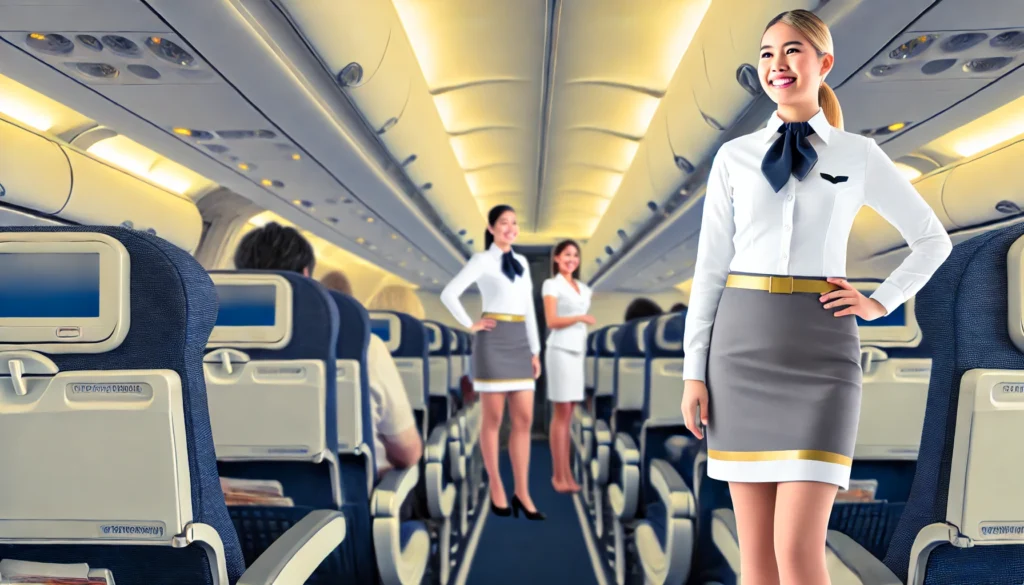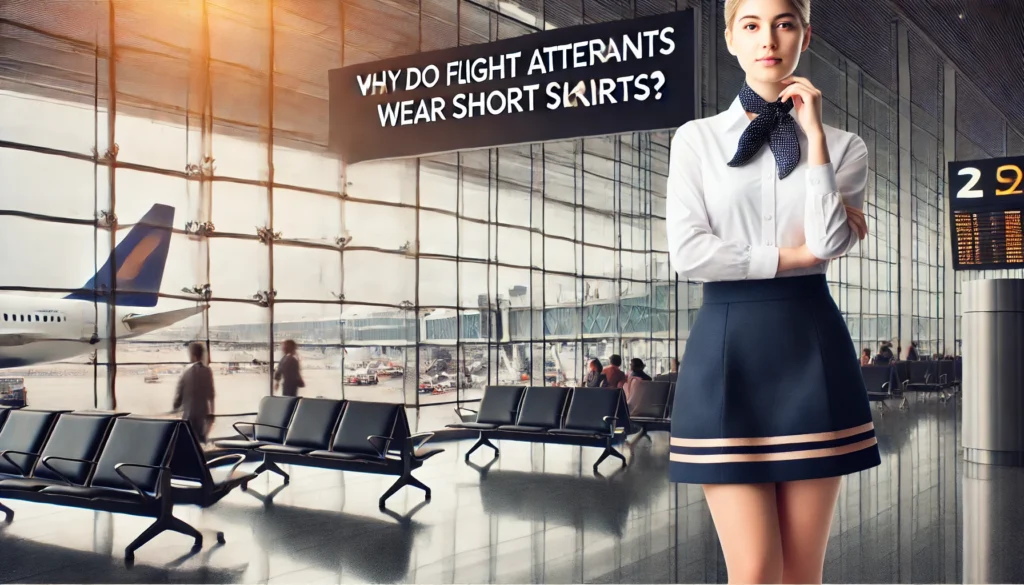Welcome to “Wings Over Cloud,” your go-to resource for all aviation knowledge. Today, we delve into a topic that often piques curiosity—why do flight attendants wear short skirts? This question opens up a discussion about the evolution of airline uniforms, the practical reasons behind these designs, and the socio-cultural implications tied to them. Let’s explore this in detail.
The Evolution of Flight Attendant Uniforms
Historical Background
Flight attendant uniforms have changed significantly since the early days of commercial aviation. In the 1930s and 1940s, uniforms were designed to reflect the elegance and glamour associated with air travel. Long skirts, tailored jackets, and even hats were common. However, as airlines started to expand and evolve, so did their uniforms.
The early uniforms were designed to mimic the look of nurses, as flight attendants were expected to provide medical assistance if needed. These early designs were practical and functional but lacked a sense of style. As the aviation industry grew, so did the need for a more polished and professional appearance.
The 1960s Revolution
The 1960s brought a significant shift in flight attendant uniforms. Airlines began to adopt more modern and stylish designs. This era saw the introduction of shorter skirts, influenced by the fashion trends of the time. The miniskirt was a symbol of youth and progressiveness, aligning with the airline’s goals to present a fresh and modern image.
Airlines like Pan Am and Braniff International were pioneers in this transformation. They hired famous designers such as Emilio Pucci and Jean Louis to create uniforms that were not only practical but also fashionable. These new designs captured the spirit of the 60s, emphasizing vibrant colors, bold patterns, and shorter hemlines.
The Influence of the 1970s and 1980s
The 1970s and 1980s continued the trend of stylish and practical uniforms. During this period, the aviation industry was booming, and airlines wanted to convey a sense of luxury and sophistication. Short skirts remained a staple, but the designs became more varied, with options for pantsuits and dresses also becoming popular.
The influence of popular culture and changing societal norms played a significant role in shaping these uniforms. Movies and television shows often depicted flight attendants as glamorous and sophisticated, reinforcing the image airlines wanted to project. This era also saw the introduction of more comfortable fabrics and innovative designs that allowed for greater ease of movement.
Practical Reasons Behind Flight Attendant Short Skirts

Ease of Movement
One of the main reasons flight attendants wear short skirts is for ease of movement. Working in the confined space of an aircraft requires agility and flexibility. Short skirts allow for greater mobility, making it easier for attendants to perform their duties efficiently.
In addition to the confined spaces, flight attendants must navigate narrow aisles and perform tasks that require bending, stretching, and lifting. Short skirts facilitate these movements without the risk of tripping or getting caught on objects. This practicality is crucial for ensuring the safety and comfort of both the flight attendants and the passengers.
Professional Appearance
Airlines aim to maintain a professional yet approachable image. Short skirts, when designed appropriately, strike a balance between professionalism and style. They convey a modern, neat, and uniform look, which is crucial for maintaining the airline’s brand identity.
The design of the uniform plays a vital role in creating a cohesive and professional appearance. Short skirts, paired with tailored jackets and accessories, create a polished and sophisticated look. This uniformity helps establish a sense of order and discipline, which is essential for the efficient operation of an airline.
Temperature Regulation
Cabin temperatures can vary, but generally, they are kept cool to ensure passenger comfort. Short skirts help flight attendants stay comfortable during long hours of work. Paired with other uniform elements like blazers and scarves, they can adapt to different temperature conditions within the aircraft.
Flight attendants often have to deal with fluctuating temperatures, from the cool cabin environment to warmer temperatures during boarding and disembarkation. Short skirts provide a practical solution by allowing for better airflow and comfort. Additionally, the use of layers in the uniform design ensures that flight attendants can adjust to different temperature conditions easily.
Uniform Maintenance
Short skirts are often easier to maintain than longer ones. They are less likely to get dirty or damaged during flights. This practicality ensures that flight attendants always look their best, contributing to the overall professional image of the airline.
The frequent wear and tear that uniforms undergo require them to be durable and easy to clean. Short skirts made from high-quality fabrics are less prone to staining and wear, ensuring that flight attendants can maintain a neat and presentable appearance throughout their shifts. This durability also extends the lifespan of the uniforms, reducing the need for frequent replacements.
Flight Attendant Wear “The Ultimate Guide To Their Stylish Look!”
Socio-Cultural Implications
Image and Branding
The uniform of a flight attendant is more than just work attire; it’s a part of the airline’s brand. Airlines invest significantly in a uniform design to ensure it aligns with their overall image. Short skirts are often chosen to reflect a youthful, energetic, and dynamic brand identity. This choice is strategic, and aimed at creating a memorable and positive impression on passengers.
The image of the flight attendant as a symbol of the airline is carefully crafted to align with the company’s marketing and branding efforts. A well-designed uniform can enhance the airline’s reputation and appeal to a broad audience. By incorporating elements such as short skirts, airlines aim to convey a sense of modernity and sophistication, appealing to passengers’ desire for a stylish and comfortable travel experience.
Changing Norms
The acceptability and appropriateness of short skirts have evolved over-time. What was once seen as daring is now often considered standard in many professional settings. Airlines continuously adapt to these changing norms to stay relevant and appealing to their customer base.
As societal attitudes toward fashion and professionalism have evolved, so too have the designs of flight attendant uniforms. Airlines must balance tradition with innovation, ensuring that their uniforms remain contemporary while respecting the heritage of the industry. This ongoing evolution reflects the broader changes in society, where fashion trends and cultural attitudes influence professional attire.
Gender Dynamics
Flight attendant uniforms have historically been more scrutinized for female attendants. However, airlines are now adopting more gender-neutral approaches. Male flight attendants often wear trousers and jackets, emphasizing practicality and professionalism equally for all genders.
The shift toward more inclusive and diverse uniform designs reflects the changing dynamics of the aviation industry. Airlines recognize the importance of providing uniforms that cater to the needs and preferences of all their staff, regardless of gender. This inclusivity not only promotes equality but also enhances the overall morale and satisfaction of the workforce.
Addressing Concerns and Misconceptions
Objectification and Professionalism
There is ongoing debate about whether short skirts objectify flight attendants. Airlines today are more aware of these concerns and strive to design uniforms that are both stylish and respectful. Many airlines involve their staff in the design process, ensuring that the uniforms are comfortable and appropriate.
To address concerns about objectification, airlines have implemented guidelines and standards for uniform design. These guidelines focus on creating uniforms that are professional, practical, and respectful of the flight attendants’ roles. By involving flight attendants in the design process, airlines ensure that the uniforms meet the needs and preferences of those who wear them, fostering a sense of ownership and pride in their appearance.
Comfort and Safety
Another important consideration is the comfort and safety of flight attendants. Uniforms must be designed to ensure that flight attendants can perform their duties without discomfort or restriction. Airlines invest in high-quality fabrics and ergonomic designs to meet these needs.
The choice of materials and the construction of the uniforms play a crucial role in ensuring the comfort and safety of flight attendants. Breathable fabrics, flexible designs, and ergonomic features are essential components of modern flight attendant uniforms. These elements contribute to the overall well-being of the staff, enabling them to perform their duties effectively and efficiently.
Personal Insights and Experiences
Voices from the Industry
Many flight attendants share positive experiences regarding their uniforms. They appreciate the blend of style and practicality. The design of the uniform, including the short skirt, often makes them feel part of a professional and esteemed team. However, feedback mechanisms are in place to address any discomfort or concerns about uniform elements.
Flight attendants often express pride in their uniforms, seeing them as a symbol of their professionalism and dedication to their roles. Positive feedback from passengers and colleagues further reinforces this sense of pride. However, airlines are committed to continuous improvement, regularly seeking feedback from their staff to ensure that the uniforms remain comfortable, practical, and appropriate.
Adaptation and Modernization
Airlines are increasingly incorporating feedback from their staff to modernize uniforms. This includes offering different lengths and styles to cater to individual preferences and body types. The goal is to ensure that every flight attendant feels comfortable and confident in their attire.
The process of modernizing uniforms involves collaboration between designers, flight attendants, and airline management. By considering the diverse needs and preferences of their staff, airlines can create uniforms that are inclusive and adaptable. This approach not only enhances the comfort and satisfaction of flight attendants but also reflects the airline’s commitment to diversity and inclusivity.
Can Flight Attendants Have Nose Rings? Discover the Startling Truth!
The Role of Media and Pop Culture
Influence of Movies and Television
Movies and television have played a significant role in shaping public perceptions of flight attendant uniforms. Iconic images from films often highlight the elegance and style of these uniforms, contributing to their mystique and allure. This media portrayal has both positive and negative impacts, influencing both public expectations and the actual design choices made by airlines.
Popular media often romanticizes the role of the flight attendant, portraying them as glamorous and sophisticated. This portrayal influences public perceptions and expectations, shaping the image of flight attendants in popular culture. Airlines leverage this influence by designing uniforms that align with these positive associations, enhancing their brand image and appeal.
Fashion Industry Impact
The fashion industry also has a strong influence on flight attendant uniforms. Designers often collaborate with airlines to create uniforms that are trendy yet functional. These collaborations ensure that uniforms are not only practical for work but also stylish and modern, reflecting the latest fashion trends.
Collaborations with renowned fashion designers bring a fresh perspective to uniform design, incorporating the latest trends and innovations. These partnerships result in uniforms that are both stylish and practical, meeting the needs of flight attendants while enhancing the airline’s brand image. The influence of the fashion industry ensures that flight attendant uniforms remain contemporary and appealing.
Why Do Flight Attendants Wear Short Skirts “Final Thoughts”

So, why do flight attendants wear short skirts? The answer lies in a combination of historical evolution, practical needs, branding strategies, and cultural influences. Short skirts offer ease of movement, maintain a professional appearance, and align with modern fashion trends. While there are ongoing discussions about the appropriateness of such uniforms, airlines continuously adapt to ensure they meet the needs and preferences of their staff while maintaining their brand identity.
As we continue to see changes in fashion and societal norms, flight attendant uniforms will undoubtedly evolve. The goal remains to balance practicality, professionalism, and style, ensuring that flight attendants can perform their duties comfortably and confidently.
For more insights into the world of aviation, stay tuned to “Wings Over Cloud.” We aim to provide you with engaging and informative content that answers your questions and fuels your passion for flying. If you have any topics you’d like us to cover, feel free to reach out! Also, Check Out Our All New Product Range.
8 Highest Paying Airlines for Flight Attendants “Discover the Best!”

